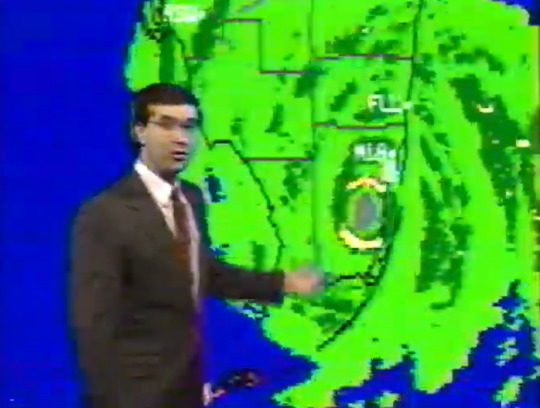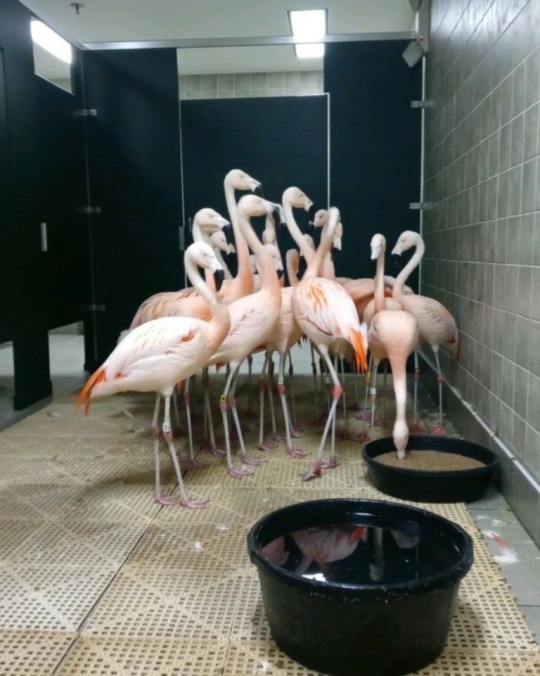#hurricane andrew
Text

August 2022 marks the 30th anniversary of Hurricane Andrew making it's historic impact on the Bahamas, southern Florida, Louisiana, Mississippi, and other parts of the south and east in 1992. It was the first category 5 hurricane to make landfall in the United States since Hurricane Camille in 1969. Since Andrew, only one other category five hurricane has made a US landfall: Hurricane Michael in 2018.
Adjusted for inflation, Hurricane Andrew caused almost $50 billion in damage, leading to the collapse of Florida's homeowner insurance system. In the years since, building codes were vastly improved in south Florida to withstand powerful hurricanes.
65 people died as a result of the storm, with most fatalities occurring during the recovery phase due to accidents and medical emergencies. Given the enormous amount of damage Hurricane Andrew caused, the shockingly low death toll (especially in Florida) has sometimes been partially credited to meteorologist Bryan Norcross and his 23-hour-long broadcast before, during, and after Andrew made its first US landfall. As the hurricane battered the television studio in downtown Miami, Norcross kept up a calm, steady flow of information and encouragement to everyone listening/watching, even as the storm forced him and his fellow anchors into a small concrete "bunker" for safety.
A humanitarian crisis grew in the aftermath of Hurricane Andrew. Neither President George H. W. Bush nor Florida Governor Lawton Chiles wanted to take responsibility for the government's delayed response to Kate Hale (Miami's deputy emergency management coordinator) and her requests for help in south Florida. With few structures remaining operable, people were becoming dehydrated from lack of water, starving from a lack of food, and desperation grew more prevalent among the survivors. Even with private citizens from all over the country attempting to help the people in south Florida, it wasn't enough. Society broke down into lawlessness and fear. Government reinforcements finally arrived almost a week after Andrew ravaged southern Florida and the northern Gulf coast. 1992 was an election year, and many people cited Bush's delayed disaster response as the reason they voted for his rival, Bill Clinton.
Hurricane Andrew had lasting ripple effects on everything from the insurance industry, to the local ecology (displaced pet pythons formed a breeding population in the Everglades, for example), to national politics. Though its legacy has been eclipsed by arguably more catastrophic hurricanes like Katrina, Maria, and Michael, Andrew marked the beginning of a new era of devastating hurricanes to ravage a more connected United States. In 1992, cell phones, live satellite feeds, cable TV, rudimentary internet, and improved computer modeling kept Americans all over the country informed about Hurricane Andrew in a way that didn't happen just a few years earlier with Hurricane Hugo. Hurricane Andrew marks a milestone in modern disaster messaging and communications.
As we progress through yet another hurricane season, let's not forget the lessons that Hurricane Andrew taught us 30 years ago. 1) Be prepared BEFORE disaster strikes. 2) Working together for the greater good can literally save lives. 3) If authorities tell you to evacuate, LEAVE. 4) A battery powered radio is a lifeline when the electricity goes out. 5) Studying history can prepare us for the future.
Thanks for reading, and stay safe.
***
edit: This was in my drafts. I forgot to post it back in August. I didn't want to delete it, so I'll just post it now, a day late and a dollar short. IDK if anyone following me will get anything out of it, but I like writing essays, so...here ya go.
#hurricane andrew#hurricane season#hurricane#i wrote this essay for fun#i hope y'all enjoy it#i can talk about this particular hurricane forever#and ngl i mostly wrote this#so i could have an excuse#to post that news anchor's outfit#that contrast stitching is putting in some WORK y'all
15 notes
·
View notes
Text
Hurricane Andrew – 30 years on from devastating storm
Hurricane Andrew – 30 years on from devastating storm
Insured losses from the storm in Florida alone were $15.5 billion and economic losses totaled more than $26 billion, according to Swiss Re.
Andrew’s direct death toll has been described by the National Hurricane Center (NHC) as “remarkably low considering the destruction”. Sixty-five (65) people are widely reported to have died indirectly or directly due to the storm.
In Dade County, around…
View On WordPress
2 notes
·
View notes
Text

Radar pictures of Hurricane Andrew as it made landfall on Florida, emphasis on eye and eyewall
Coverage by WTVT Tampa Bay
Time unknown, 1992/05/24
[x]
1 note
·
View note
Text
June 1st marks the official start of the Atlantic basin hurricane season. Though there is now a pre-season which starts on May 15th.
It's predicted to be near average this year. Though what is considered average has been creeping up in recent decades.
CNN tracked two hurricane season outlooks this year: the forecast from the National Oceanic and Atmospheric Administration, which was released last week, and another from researchers at Colorado State University, who have been issuing seasonal forecasts for more than 37 years.
NOAA officials are predicting an average hurricane season, with 12 to 17 named tropical storms, five to nine of which could become hurricanes. They expect as many of four of those could strengthen into major hurricanes – category 3 or stronger.
A slightly more optimistic prediction from tropical cyclone Dr. research scientist Dr. Philip J. Klotzbach.
Phil Klotzbach, a research scientist at Colorado State, said in April his group was predicting a slightly below-average season this year: 13 named storms, six hurricanes and two major hurricanes.
The key difference between tropical depressions, tropical storms and hurricanes lies in their wind speeds and the level of organization within the system.
While a tropical depression represents the earliest stage of cyclone development, named tropical storms exhibit more structure and stronger winds. Hurricanes — the most powerful and dangerous of the three — possess the strongest winds and a well-defined eye, making them capable of causing extensive damage over large areas.
According to the National Hurricane Center, there is already a disturbance in the Gulf of Mexico with a 70% chance of tropical cyclone formation in the next two days. Look for updates here.
Even a season which starts off calm can take an abrupt turn.
In 1992 there had been no named storms for the first 11 weeks of the season. Then on August 17th a nondescript tropical wave in the Atlantic became the first named storm of the year. Rapid intensification transformed this storm into Category 5 Hurricane Andrew. It cut through the south of Florida like a buzz saw and had a second act as it stormed through the Gulf and made a second landfall in Louisiana.
Hurricane Andrew
Andrew's style of rapid intensification has become more common in the 21st century.
This season should not be as bad as 2020 when they ran out of hurricane names and then burned through half of the Greek alphabet.
youtube
Yep, one tropical storm in 2020 even made landfall in Portugal. 🇵🇹
Warm seas give hurricanes more strength and make their formation more likely. The unmistakable warming of the Atlantic is responsible for the spike in major hurricanes this century.
#hurricanes#tropical cyclones#2023 hurricane season#atlantic basin hurricane season#climate change#warming oceans#increase in major hurricanes#hurricane andrew
0 notes
Text

#queue#aesthetic#retro#nostalgia#hurricane#weather#the weather channel#twc#90s#1992#1990s#florida#radar#doppler#doppler radar#hurricane andrew#news
1 note
·
View note
Text
Hurricane, Mima, Miami & Fanucci
Hurricane, Mima, Miami & Fanucci
I’ve now spent three days reading coverage of what my dad is breathlessly referring to as the “apocalyptic” situation on the west coast of Florida, following Hurricane Ian’s landing on Thursday. I live on the east coast of Florida and it might just as well’ve landed here and wrought the same havoc. Worst we would’ve seen since 1992.
I was a year old when Hurricane Andrew hit my childhood home…

View On WordPress
#cnn#cuban revolution#diary#don fanucci#family#godfather#godfather 2#godfather II#hurricane andrew#hurricane ian#hurricane katrina#hurricane recovery#mario puzo#memory#miami#miami dade#miami hurricane#mima#new orleans#personal#trauma#tropical storm#wala#war#world war one#world war two
1 note
·
View note
Text

Beastie Boys, 1987, © Andrew Catlin
215 notes
·
View notes
Photo










Simon Casey | Teachers | requested by Anonymous
#here ya go! 💚#Andrew Lincoln#Simon Casey#Teachers#*#sc#you're right it had been too long#an absolute mess of a man child that i would have let ghost me past the level of any self respect#*obligatory 'i would have put up with his shit too maggie' tag*#Maggie: *roasts him to death* *still bangs him like a screen door in a hurricane* my aesthetic#if you're an andy fan and you've never seen teachers i don't know what you're doing#i will use any excuse to gif the scene of him drinking wine in bed because that is so much my aesthetic i can't even tell ya#that massive jumper in the last gif 💓💓💓#one day your lips will not make me want to bust through a wall like the koolaid man#but today is not that day#can't believe tumblr is letting the gif of him adjusting the wedding vegetables post#normally they hate it#fuzzies ✨#his impression of crabs makes me laugh every time
139 notes
·
View notes
Text







if you can't find your way out of the dark, i'll sit with you in it.
hozier, unreal unearth
#i'm feeling so feral about this fr#like! what if your pain was harsh as a hurricane! and i moved the earth and the sun to make it easier for you to bear!#what if me taking your weight broke me! but i asked them to put me back in it! as long as that made it easier for you to bear!#hozier#unreal unearth#de selby part 2#francesca#i carrion (icarian)#andrew hozier byrne
38 notes
·
View notes
Text
Climate experts fear Donald Trump will follow a blueprint created by his allies to gut the National Oceanic and Atmospheric Administration (NOAA), disbanding its work on climate science and tailoring its operations to business interests.
Joe Biden’s presidency has increased the profile of the science-based federal agency but its future has been put in doubt if Trump wins a second term and at a time when climate impacts continue to worsen.
The plan to “break up NOAA” is laid out in the Project 2025 document written by more than 350 rightwingers and helmed by the Heritage Foundation. Called the Mandate for Leadership: The Conservative Promise, it is meant to guide the first 180 days of presidency for an incoming Republican president.
The document bears the fingerprints of Trump allies, including Johnny McEntee, who was one of Trump’s closest aides and is a senior adviser to Project 2025. “The National Oceanographic [sic] and Atmospheric Administration (NOAA) should be dismantled and many of its functions eliminated, sent to other agencies, privatized, or placed under the control of states and territories,” the proposal says.
That’s a sign that the far right has “no interest in climate truth”, said Chris Gloninger, who last year left his job as a meteorologist in Iowa after receiving death threats over his spotlighting of global warming.
The guidebook chapter detailing the strategy, which was recently spotlighted by E&E News, describes NOAA as a “colossal operation that has become one of the main drivers of the climate change alarm industry and, as such, is harmful to future US prosperity”. It was written by Thomas Gilman, a former Chrysler executive who during Trump’s presidency was chief financial officer for NOAA’S parent body, the Commerce Department.
Gilman writes that one of NOAA’S six main offices, the Office of Oceanic and Atmospheric Research, should be “disbanded” because it issues “theoretical” science and is “the source of much of Noaa’s climate alarmism”. Though he admits it serves “important public safety and business functions as well as academic functions”, Gilman says data from the National Hurricane Center must be “presented neutrally, without adjustments intended to support any one side in the climate debate”.
But NOAA’S research and data are “largely neutral right now”, said Andrew Rosenberg, a former NOAA official who is now a fellow at the University of New Hampshire. “It in fact basically reports the science as the scientific evidence accumulates and has been quite cautious about reporting climate effects,” he said. “It’s not pushing some agenda.”
The rhetoric harkens back to the Trump administration’s scrubbing of climate crisis-related webpages from government websites and stifling climate scientists, said Gloninger, who now works at an environmental consulting firm, the Woods Hole Group.
“It’s one of those things where it seems like if you stop talking about climate change, I think that they truly believe it will just go away,” he said. “They say this term ‘climate alarmism’ … and well, the existential crisis of our lifetime is alarming.”
NOAA also houses the National Weather Service (NWS), which provides weather and climate forecasts and warnings. Gilman calls for the service to “fully commercialize its forecasting operations”.
He goes on to say that Americans are already reliant on private weather forecasters, specifically naming AccuWeather and citing a PR release issued by the company to claim that “studies have found that the forecasts and warnings provided by the private companies are more reliable” than the public sector’s. (The mention is noteworthy as Trump once tapped the former CEO of AccuWeather to lead NOAA, though his nomination was soon withdrawn.)
The claims come amid years of attempts from US conservatives to help private companies enter the forecasting arena – proposals that are “nonsense”, said Rosenberg.
Right now, all people can access high-quality forecasts for free through the NWS. But if forecasts were conducted only by private companies that have a profit motive, crucial programming might no longer be available to those in whom business executives don’t see value, said Rosenberg.
“What about air-quality forecasts in underserved communities? What about forecasts available to farmers that aren’t wealthy farmers? Storm-surge forecasts in communities that aren’t wealthy?” he said. “The frontlines of most of climate change are Black and brown communities that have less resources. Are they going to be getting the same service?”
Private companies like Google, thanks to technological advancements in artificial intelligence, may now indeed be producing more accurate forecasts, said Andrew Blum, author of the 2019 book The Weather Machine: A Journey Inside the Forecast. Those private forecasts, however, are all built on NOAA’S data and resources.
Fully privatizing forecasting could also threaten the accuracy of forecasts, said Gloninger, who pointed to AccuWeather’s well-known 30- and 60-day forecasts as one example. Analysts have found that these forecasts are only right about half the time, since peer-reviewed research has found that there is an eight- to 10-day limit on the accuracy of forecasts.
“You can say it’s going to be 75 degrees out on May 15, but we’re not at that ability right now in meteorology,” said Gloninger. Privatizing forecasting could incentivize readings even further into the future to increase views and profits, he said.
Commercializing weather forecasts – an “amazing example of intergovernmental, American-led, postwar, technological achievement” – would also betray the very spirit of the endeavor, said Blum.
In the post-second world war era, John F. Kennedy called for a global weather-forecasting system that relied on unprecedented levels of scientific exchange. A privatized system could potentially stymie the exchange of weather data among countries, yielding less accurate results.
The founding of weather forecasting itself showcases the danger of giving profit-driven companies control, said Rosenberg. When British V. Adm Robert FitzRoy first introduced Britain to the concept of forecasts during Victorian times, he was often bitterly attacked by business interests. The reason: workers were unwilling to risk their lives when they knew dangerous weather was on the horizon.
“The ship owners said, well, that means maybe I lost a day’s income because the fishermen wouldn’t go out and risk their lives when there was a forecast that was really bad, so they didn’t want a forecast that would give them a day’s warning,” Rosenberg said. “The profit motive ended up trying to push people to do things that were dangerous … there’s a lesson there.”
#us politics#news#the guardian#2024#project 2025#donald trump#biden administration#National Oceanic and Atmospheric Administration#Mandate for Leadership: The Conservative Promise#Johnny McEntee#Chris Gloninger#global warming#climate crisis#climate change#department of commerce#Office of Oceanic and Atmospheric Research#National Hurricane Center#Andrew Rosenberg#National Weather Service#AccuWeather
10 notes
·
View notes
Text


#that’s what he gets#man thought smoking cigars would make him look cool to his incels and got throat cancer from it#gonna be gaggin for his life#meme#karma is real#lol#humor#andrew tate#incels#gonna be snatched from life from Kevin Samuels#like here come Hurricane cancerina#Greta worked that European girl witchery
26 notes
·
View notes
Text

Do you still love me?
#legacysouls#legacysouls: archie andrews#SHE IS A HURRICANE OF A GIRL ; ELENA#EDITS.#elena gilbert#archie andrews#DYNAMIC: ELENA & ARCHIE.
4 notes
·
View notes
Text
youtube
❛ 𝘐 𝘧𝘦𝘭𝘵 𝘸𝘦 𝘩𝘢𝘥 𝘢 𝘴𝘱𝘦𝘤𝘪𝘢𝘭 𝘴𝘰𝘮𝘦𝘵𝘩𝘪𝘯𝘨 ❜
#sherlock#sherlock bbc#bbc sherlock#bbc shows#i am sherlocked#benedict cumberbatch#andrew scott#sheriarty#sherlock holmes#jim moriarty#moriarty#sherlockedit#cumberbatch#video#my video edit#youtube#hurricane#fleurie#sherlockbbc#221b baker street#video edit#my video edits#daily videos#dailytvsource#tvedit
4 notes
·
View notes
Text

Flamingos evacuated to the bathroom at Sunken Gardens, St Pete.
#strq.txt#.ph#saw this on twitter and it made me think of the very similar 1992 picture#the one from hurricane andrew
10 notes
·
View notes
Link
It’s already early May and that means it’s getting close to the start of the North Atlantic Basin tropical cyclone season.
If you live on or relatively close to the coast of the North Atlantic, Gulf of Mexico, or the Caribbean Sea, this is a good time to become reacquainted with how to deal with tropical cyclones. The link above provides an excellent set of reminders.
Every day during the hurricane season I visit the official NOAA site. Getting accurate information is essential in an era of disinformation.
National Hurricane Center
If you’re looking for a general forecast for the 2023 season, the go-to place is the Colorado State University Hurricane Seasonal Forecasting site. It’s ironic that a landlocked Mountain state has a university known for it’s tropical weather expertise, but the CSU team is top notch.
Here is their extended-range forecast issued on April 13th.
If you want the TL;DR forecast that isn’t over 40 pages long, here is what they predict for 2023.

So it looks like a slightly below average season in terms of activity.
But even a low activity season can bring destruction. The 1992 Atlantic season had just six named storms – but the first of those was Category 5 Hurricane Andrew which made landfall both in Florida and in Louisiana.
#tropical cyclones#2023 atlantic basin hurricane season#hurricanes#tropical storms#2023 extended range forecast#national hurricane center#noaa#el niño#hurricane preparedness week#hurricane andrew#colorado state university
0 notes
Link
“Upon receipt of unevaluated intelligence information from Australia, the FBI swiftly opened the Crossfire Hurricane investigation. In particular, at the direction of Deputy Director Andrew McCabe, Deputy Assistant Director for Counterintelligence Peter Strzok opened Crossfire Hurricane immediately. Strzok, at a minimum, had pronounced hostile feelings toward Trump.”
“The matter was opened as a full investigation without ever having spoken to the persons who provided the information. Further, the FBI did so without (i) any significant review of its own intelligence databases, (ii) collection and examination of any relevant intelligence from other U.S. intelligence entities, (iii) interviews of witnesses essential to understand the raw information it had received or (iv) using any of the standard analytical tools typicallv employed by the FBI in evaluating raw intelligence,” the report concluded.
“Had it done so … the FBI would have learned that their own experienced Russia analysts had no information about Trump being involved with Russian leadership officials, nor were others in sensitive positions at the CIA, the NSA, and the Department of State aware of such evidence concerning the subject. In addition, FBI records prepared by Strzok in February and March 2017 show that at the time of the opening of Crossfire Hurricane, the FBI had no information in its holdings indicating that at any time during the campaign anyone in the Trump campaign had been in contact with any Russian intelligence officials,” it said.
“In the eighteen months leading up to the 2016 election, the FBI was required to deal with a number of proposed investigations that had the potential of affecting the election. In each of those instances, the FBI moved with considerable caution. In one such matter… FBI Headquarters and Department officials required defensive briefings to be provided to Clinton and other officials or candidates who appeared to be the targets of foreign interference,” it said. “In another, the FBI elected to end an investigation after one of its longtime and valuable CHSs went beyond what was authorized and made an improper and possibly illegal financial contribution to the Clinton campaign on behalf of a foreign entity as a precursor to a much larger donation being contemplated.”
“And in a third, the Clinton Foundation matter, both senior FBI and Department officials placed restrictions on how those matters were to be handled such that essentially no investigative activities occurred for months leading up to the election. These examples are also markedly different from the FBI’s actions with respect to other highly significant intelligence it received from a trusted foreign source pointing to a Clinton campaign plan to vilify Trump by tying him to Vladimir Putin so as to divert attention from her own concerns relating to her use of a private email server,” it said.
“Within days after opening Crossfire Hurricane, the FBI opened full investigations on four members of the Trump campaign team: George Papadopoulos, Carter Page, Paul Manafort, and Michael Flynn. No defensive briefing was provided to Trump or anyone in the campaign concerning the information received from Australia that suggested there might be some type of collusion between the Trump campaign and the Russians, either prior to or after these investigations were opened. Instead, the FBI began working on requests for the use of FISA authorities against Page and Papadopoulos.”
“Our investigation determined that the Crossfire Hurricane investigators did not and could not corroborate any of the substantive allegations contained in the Steele reporting. Nor was Steele able to produce corroboration for any of the reported allegations, even after being offered $1 million or more by the FBI for such corroboration.
“The FBI learned that Steele relied primarily on a U.S.-based Russian national, Igor Danchenko, to collect information that ultimately formed the core allegations found in the reports. Specifically, our investigation discovered that Danchenko himself had told another person that he (Danchenko) was responsible for 80% of the ‘intel’ and 50% of the analysis contained in the Steele Dossier.”
“In December 2016, the FBI identified Danchenko as Steele’s primary sub-source. Danchenko agreed to meet with the FBI and, under the protection of an immunity letter… the FBI conducted multiple interviews of Danchenko regarding, among other things, the information he provided to Steele,” it said. “Danchenko was unable to provide any corroborating evidence to support the Steele allegations, and further, described his interactions with his sub-sources as ‘rumor and speculation’ and conversations of a casual nature. Significant parts of what Danchenko told the FBI were inconsistent with what Steele told the FBI during his prior interviews in October 2016 and September 2017. At no time, however, was the FISC informed of these inconsistencies. Moreover, notwithstanding the repeated assertions in the Page FISA applications that Steele’s primary sub-source was based in Russia, Danchenko for many years had lived in the Washington, D.C. area.”
“The FBI knew in January 2017 that Danchenko had been the subject of an FBI counterintelligence investigation from 2009 to 2011. In late 2008, while Danchenko was employed by the Brookings Institution, he engaged two fellow employees about whether one of the employees might be willing or able in the future to provide classified information in exchange for money. According to one employee, Danchenko believed that he (the employee might be following a mentor into the incoming Obama administration and have access to classified information. During this exchange, Danchenko informed the employee that he had access to people who were willing to pay for classified information.”
“The FBI converted its investigation into a full investigation after learning that Danchenko (i) had been identified as an associate of two FBI counterintelligence subjects and (ii) had previous contact with the Russian Embassy and known Russian intelligence officers… at that earlier time, Agents had interviewed several former colleagues of Danchenko who raised concerns about Danchenko’s potential involvement with Russian intelligence. For example, one such colleague, who had interned at a U.S. intelligence agency, informed the Office that Danchenko frequently inquired about that person’s knowledge of a specific Russian military matter.”
You can read the report here.
#Durham report#Russia#FBI#collusion#Daily Wire#corruption#Hillary Clinton#Luke Rosiak#George Papadopoulos#John Durham#Steele dossier#Crossfire Hurricane#Clinton Foundation#Christopher Steele#Carter Page#Trump administration#Peter Strzok#Paul Manafort#Andrew McCabe#Igor Danchenko
1 note
·
View note